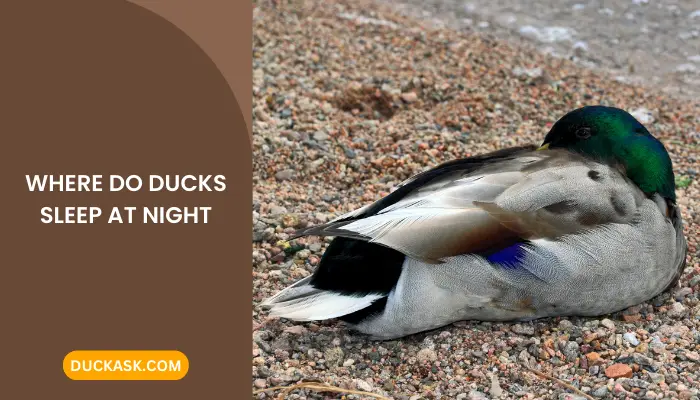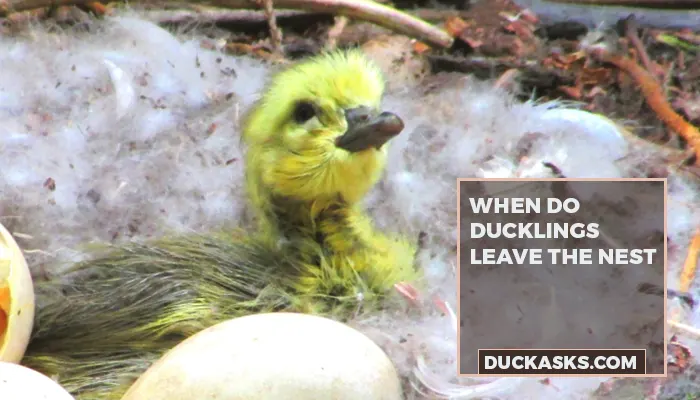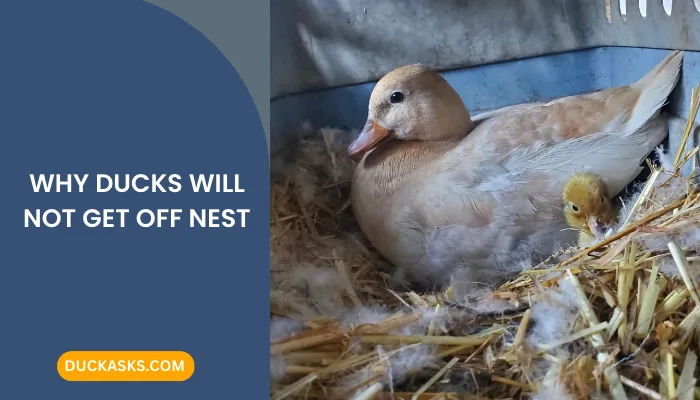Why Do Wood Ducks Nest in Trees?
The vividly colorful Wood Ducks have a much different nesting habit than other water-bound birds. Instead of choosing ground-level sites to build their homes, they choose cavitation in tall trees.
But why do wood ducks’ nest in trees? Wood ducks fall into the cavity nesting birds category, core reasons for building tree nests mostly involve survival. The height helps their homes to avoid detection from predators. And since other waterfowl species can’t build their nest high up, they get to avoid competition for nesting opportunities.
You might have found wood ducks’ nesting behaviors odd. Also, what special abilities let them build nests on trees while other ducks cannot? Find the answers in the following discussion.

The Reasons Why Wood Ducks Build Their Nests in Trees
Wood ducks build their nests in trees and this differs from the nesting behaviors of other waterfowl, who mostly prefer ground-level sites.
The reason mainly has to do with the birds’ instincts. They are secondary cavity nesting birds. Therefore, wood ducks are naturally driven towards tree hollows when it comes to nesting.
They would choose a deep tree hollow several meters above the ground. You might find a wood duck nest in the natural cavities of an oak, maple, beech, or bald cypress trees.
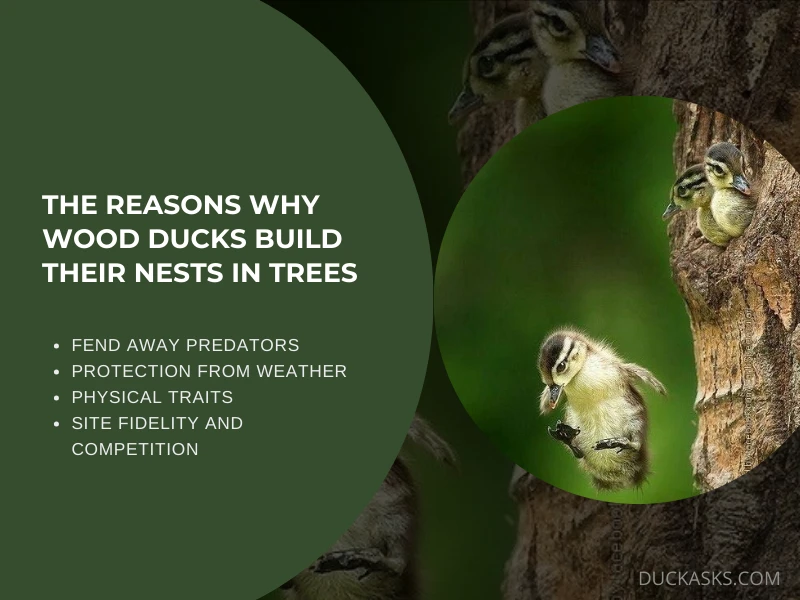
Here are some of the reasons why a wood duck builds a nest in trees –
Fend Away Predators
Wood ducks, especially their hatchlings, are a favorite target of various predators. These ducks are slightly smaller than Mallards and some common duck species. As a result, they might seem like an easier target to the predators.
These include foxes, minks, raccoons, snakes, and largemouth bass. Ground nests make it easier for predators to find and hunt wood ducks.
In contrast, a nest several meters above the ground is often inaccessible to these predators. Most of them won’t climb that far to hunt the ducks.
Plus, being high above the ground makes their nests almost undetectable to these hunters.
Protection from Weather
Wood duck’s reproductive season is during early spring. This is when the temperatures are still cold enough for baby ducks. On the other hand, it’s warm enough for the winter ice to melt and cause the ponds and lakes to suddenly flood.
Building nests high above the ground protects them from cold and floods. The deep natural tree hollows are also excellent shelters from rain and wind.
Physical Traits
The Wood Ducks’ unique physical abilities are one of the main reasons they can build their nest on trees.
Most ducks are not good grippers or climbers. But that’s not true for the wood ducks. They have extraordinarily sharp and strong claws that can easily climb trees and grip the creases.
Also, most waterfowl do not have good perching abilities. Which means they cannot efficiently balance themselves on tree branches. This isn’t true for wood ducks whose perching abilities are excellent.
These physical traits make it easy for the wood ducks to live on trees. Thus, they choose these sites to build their nests.
Site Fidelity and Competition
Wood ducks develop a strong preference for the sites they build their nest in. Once they have nested somewhere, they will return to that site year after year to hatch and raise their young.
Tree nests are perfect for accommodating this behavior of wood ducks. Unlike ground-level homes, tree nests have less chances of being washed away by floods. They are also protected from human activities like plowing or mowing.
Also, many experts agree that resource competition drove wood ducks to their tree nests.
For instance, other waterfowl also seek nesting opportunities in the swamps and wetlands. By choosing trees, the wood ducks avoid competition, reproduce more successfully, and rapidly colonize the new area.
How Do Wood Ducks Build their Nests in Trees?
Wood ducks don’t build their nests in the traditional sense. For them, it’s more about finding the perfect cavity in a suitable tree.
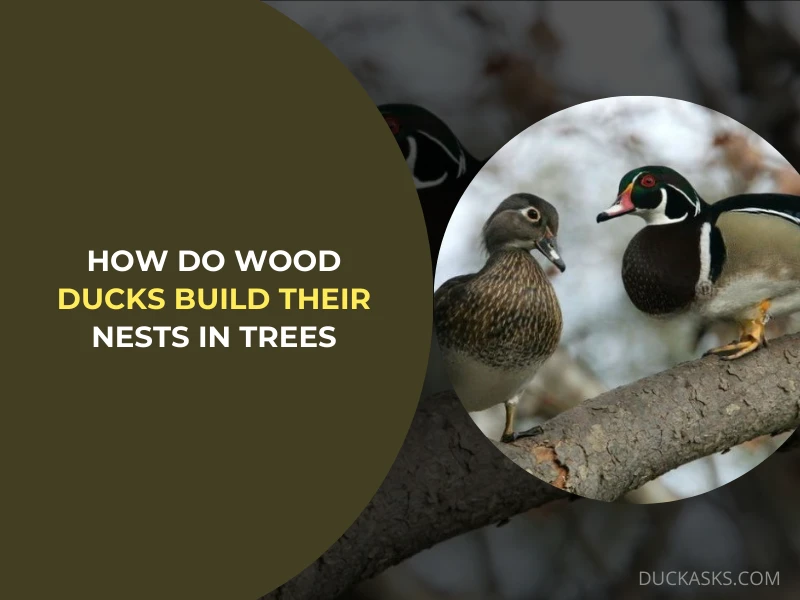
Most of these hollows form due to decades of decay. Fire, wind, or lightning plays an important role in forming these cavities. Woodpeckers or other animals might have also helped with the excavation.
Once the Wood Ducks settle in a hollow, the female plucks feathers from her breast to line the nest. To hide their nest and hatchlings, the ducks will blanket the nest with grass, bulrushes, cattails, sedges, and other emergent vegetation.
How High off the Ground do Wood Ducks Typically Nest in Trees?
On average, the Wood Duck’s nest is 7.6 meters or 25 feet above the ground. However, some wood ducks can nest as low as 2 feet from ground level.
Meanwhile, sometimes, they might nest at a height of 17 meters or 56 feet.
Suck variations in height occur because wood ducks can’t make their own hollows. Therefore, they must build the nests wherever they find one.
What Kind of Trees Do Wood Ducks Prefer for Nesting?
Oak, Maple, Tupelo, Ash, Black gum, Aspen, Sycamore, Beech, and Bald Cypress are some of the trees in which wood ducks build their nests.

Wood Ducks usually prefer tall trees that are close to the wetlands. This ensures the ducks have protected nests and easy access to their food. Usually, a Wood Duck’s tree nests have the following features –
Deep Hollow
Wood ducks set up their nest in deep natural hollows of trees. You can expect these hollows to be at least 10 inches in diameter and 24-inch depth.
The entrance needs to be at least 4 inches in diameter. Usually, the hollow will be facing an open area or water. It also has a clear, unobstructed flight path so the ducks can easily fly in and out of the nest.
Such deep natural hollows only occur in considerably old and mature trees. It requires decades or centuries of gradual decaying for these cavities to form. This is also one of the reasons why wood ducks have a hard time finding a perfect nest.
Proximity to Water
Wood Ducks’ nests are mostly found in upland forests less than a mile from water. They also prefer flooded forests. There should be ponds, swamps, marshes, and streams nearby.
An area with open water and dense vegetation provides the perfect environment for the wood ducks to thrive. The seeds, aquatic plants, insects, and snails these ducks feed on is abundant in these areas.
Also, wood duck’s offspring would jump into the water shortly after they hatch. Proximity to a pond or lake ensures that the ducklings can land safely.
Do Wood Ducks Lay Eggs in Trees?
Wood ducks build and return to their tree nests mainly to lay eggs. A female duck would lay around 10-15 eggs in one reproductive session. The female usually lays one egg per day and eggs look dull white color.

Sometimes, a wood duck’s nest may contain more than 10-15 eggs. That’s because another female, who doesn’t have a nest, might have also used this tree hollow to lay her eggs. This behavior is known as egg-dumping.
Wood Duck Production and Egg Incubation
Typically, wood ducks lay their eggs at the end of winter. Which means they would lay the eggs within the period of February to April. Sometimes, the birds might attempt another brood in May.
The drakes of the species have nothing much to do with the eggs. Most of them return to the male flocks after mating. Others hang around halfway through the incubation period.
A female usually incubates an egg for 30 days. Some eggs can take as long as 37 days to hatch.
The interesting fact is, that the female duck doesn’t start the incubation until it lays all the eggs off of her. Once all the eggs have been laid, the incubation period starts.
As a result, even though laid on different days, all the baby ducks hatch from the eggs on the same day.
How Do Wood Ducks Protect Their Nests from Predators?
The wood ducks have adopted certain nesting strategies to protect their eggs and offspring from predators. Some of their ccommonly observed tactics are –
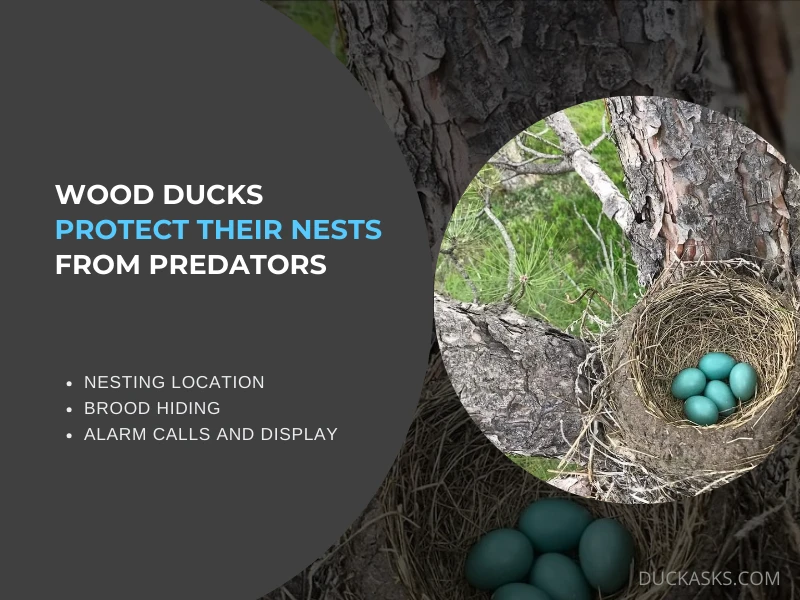
Nesting Location
They build their nests several meters above the ground in deep tree hollows. As a result, predators cannot catch the scent or see the movement of these birds.
Even if the predators become aware of the ducks’ presence, the nests are too high to access. Plus, most nests are in wetlands or flooded woodlands. And common ground predators tend to avoid such areas.
Brood Hiding
Wood Ducks blanket their offspring in various types of leaves and vegetation from the wetlands. This further mask the scent of the eggs or ducklings. Thus, avoid triggering a relentless predator in the first place.
Alarm Calls and Display
These ducks would also use alarm calls when they spot a predator nearby. These specialized call alerts all other brooding ducks in that area.
Sometimes, a duck might fall to the ground and flutter their wings. This behavior is known as a broken-wing display.
Here, the bird is pretending to be injured and distracting the predator from the nest. When the predator approaches the fallen duck, it can always move or fly away to someplace safe.
Protection from Climbing Predators
Ground predators cannot reach the wood ducks’ nests high up in the trees. However, the same isn’t true for the hunters who can climb, such as raccoons, opossums, and snakes.

These predators are agile climbers, nocturnal hunters, and have a taste for wood ducks’ eggs and meat.
In this case, human intervention can help the Wood Ducks. People trying to revive the wood duck population might build nest boxes near water to keep the birds safe from climbing predators.
Usually, these boxes have metal cones, which make it difficult for the predators to climb into the nests. Also, the entrance is designed to permit the entry of the ducks but not larger animals.
Conclusion
As you know why do wood ducks nest in trees, you might be able to help them. The rapid disappearance of trees has made it difficult for these birds to find nests. You can help them by creating wood duck boxes.
These boxes are artificial nesting sites. They have a wide circular entrance and sloping roof to mimic natural tree cavities. You can build these boxes from cypress or cedar, line them with sawdust, and place them near your local water bodies.
That’s all for this discussion. Share the knowledge with the rest of the world to raise awareness. And don’t forget to follow our Facebook, X, and Pinterest for more content like this.
Reference:
- https://www.allaboutbirds.org/guide/Wood_Duck/overview.
- https://deltawaterfowl.org/top-duck-craving-predators/.
- https://www.allaboutbirds.org/guide/Wood_Duck/id.
- https://dem.ri.gov/sites/g/files/xkgbur861/files/programs/bnatres/fishwild/pdf/woodduck.pdf.
- https://animalia.bio/wood-duck.
- https://www.nwf.org/Educational-Resources/Wildlife-Guide/Birds/Wood-Duck
Image Credits:
- Pinterest.com/pin/745275438359972061/
- Pinterest.com/pin/296533956729748444/
- Pinterest.com/pin/505318020702785594/

